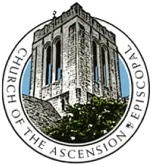From the Rector…
When my sister was little, my father convinced her that black and white photographs were pictures taken before color entered the world. We had been looking at pictures from the early 1900s of various family members when film was in black and white, not the world. (In case you were wondering—the world has always been in color also the earth is round, not flat.) My mom and I played along with my dad for a few minutes, but as a four-year-old, my sister was quite tenacious and soon got the truth out of us.
My mother used the conversation as an opportunity to talk about what colors we would have seen had the film been in color—the color of the dresses and the houses and the cars. She didn’t comment on the creation colors, those seemed rather obvious. But I wonder how she might have described them—maybe just green and yellow and blue or maybe by their shades or intensity. When I see black and white or sepia photos now, I always wonder how deep the color might have been or if I would have been surprised by something in the photo. It makes me wonder why God chose the various colors and shades in creation and how we have come to associate them with certain aspects of life.
There is something deeply spiritual in color. We have a tradition of liturgical colors—colors that express certain aspects of our theology during various times of the year. We all know Lent is purple and Christmas is red and green. Haha! Just kidding, Christmas is white. I wonder if we ever really take the time to consider the creative underlying theology of those particular colors.
Take the Sarum blue we use at Advent. That particular shade of blue is reminiscent of the night sky in-between dusk and midnight. It is the time when we go to bed in hopeful preparation for the morning to come. Advent is a season of preparation and waiting in hope for the return of Christ—even as we prepare to celebrate his Nativity. The color blue we use in church connects us in deep ways to that hope in the midst of the darkest of times in the calendar year. Sarum blue calls out the darkness of despair that we can sometimes get lost in and infuses it with the light of our hope—of the coming dawn—because we know the darkness will not last.
Green is the color of Ordinary Time—the seasons after Epiphany and Pentecost. These are our longest two seasons of the church calendar. The green calls to mind nature and reminds us to not take the green of the grass and trees and flowers and plants for granted. We become so used to them in their ordinariness, we forget how extraordinary they truly are—just as Jesus’ life was extraordinary every day he walked on the planet even when he wasn’t performing some miracle. It is in the ordinary, everyday aspects of our lives we are called to truly live.
This summer we not only have a green hanging it is a hanging filled with the colors of creation. It is a little more challenging to see on the high altar, but if you’ve ever noticed the chapel altar you can almost read the hanging from left to right—the sun and its rays in yellow and orange, a strip of blue sky, shades of green that shape the land, and finally the deep blue of the waters that form the seas. It is an intensely beautiful piece of art—not simply a cloth frontal for the altar. It connects us to the very breath of God—the wind that moved over the waters and separated the light from the dark. It connects us to the creation story. And it was good.
Many of our children are spending some time this week working with the colors of creation. They are learning the story of how God created the world and making art that reflects their own imaginative ideas of the colors and shapes and forms that God inspired in that act of creation. All of that will be on display at the Colors of Creation Art Show Thursday from 5-6pm. I hope you will come and take some time to immerse yourself in the experience of art and creation.
Light and Life,
Candice+
P. S. I did not realize how many of you were already so well versed in the understanding of Christian Nationalism and the dangers it poses for both Christianity and our country. Thank you for the many responses to my sermon on Sunday and especially for the many recommendations of news articles, books, podcasts, and the like. I am heartened to know that so many of you are already alert and concerned about the challenges that Christian Nationalism offer to our faith and democracy.
